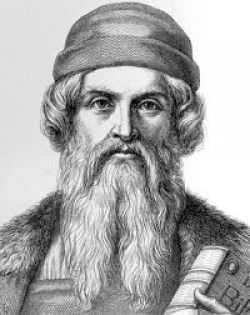They are genius men. - Sixth Series - Johannes Gutenberg (1398 - 1468)
Johannes Gutenberg life, biography, person who implements modern printmaking in Europe,
Johannes Gutenberg (1398 - 3 February 1468) is a jeweler, printer and publisher who started printing prints with moving parts in Europe in 1447. Gutenberg's discovery is the most important event of the modern era and the beginning of the printing revolution, itself the father of modern printing.
Its real name is Johannes Gensfleisch zur Laden. While working as a jewelry shop, he was driven to Strasbourg in 1435. He worked for a while on precious stone processing and painting, and started to be interested in printing business since 1437.

The pattern or letters used at that time developed a xylography technique consisting of engraved wooden planks, bringing together certain letters and finding typography based on a large number of printing techniques (1450). In 1448, when he was unable to pay his debts to Johann Fust, who had borrowed money from the printing press in 1448, Fust became a publisher, and in 1455 he applied to the court and handed over the 42-page Bible, known as the Gutenberg Bible, In 1457 he sank Mainzer Psalterium (Mainz Mezamiri) with Peter, the son-in-law who worked for Gutenberg for 5 years.
The last years of his life led Gutenberg, who was in poverty, to resume his work by taking the protection of Adolf von Nassau, the Archbishop of Mainz II (1465), and his discovery quickly spread throughout Europe. In 1901 a museum was established in Mainz and immortalized.
The last years of his life led Gutenberg, who was in poverty, to resume his work by taking the protection of Adolf von Nassau, the Archbishop of Mainz II (1465), and his discovery quickly spread throughout Europe. In 1901 a museum was established in Mainz and immortalized.
This post has received a 0.31 % upvote from @drotto thanks to: @hasancantaskiran.